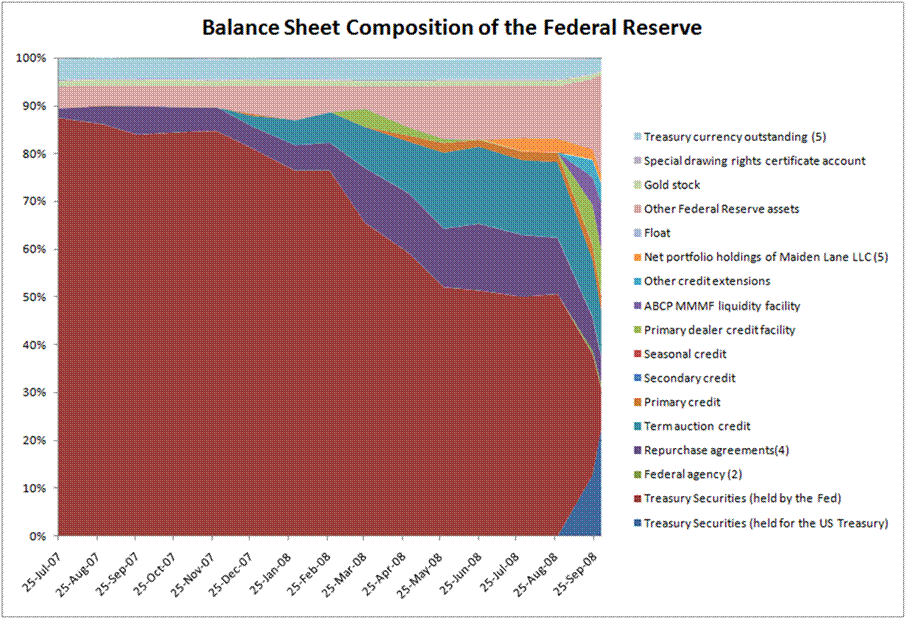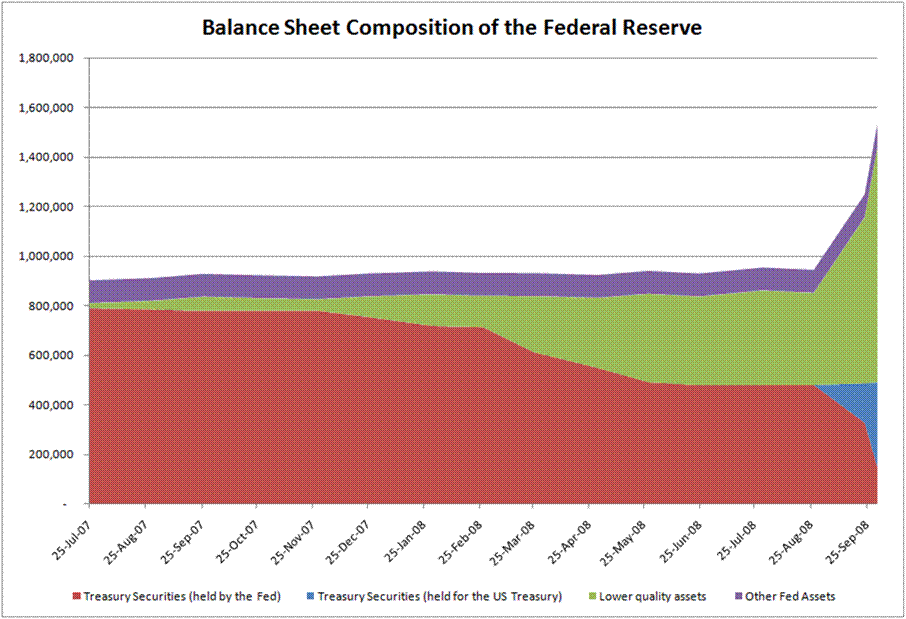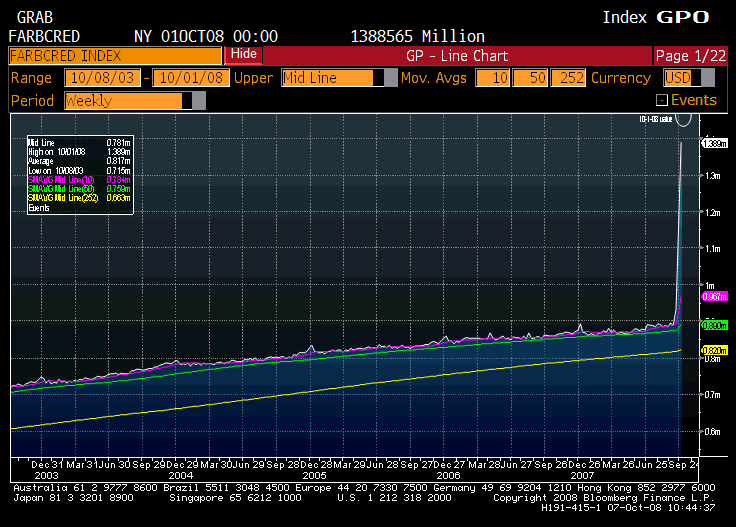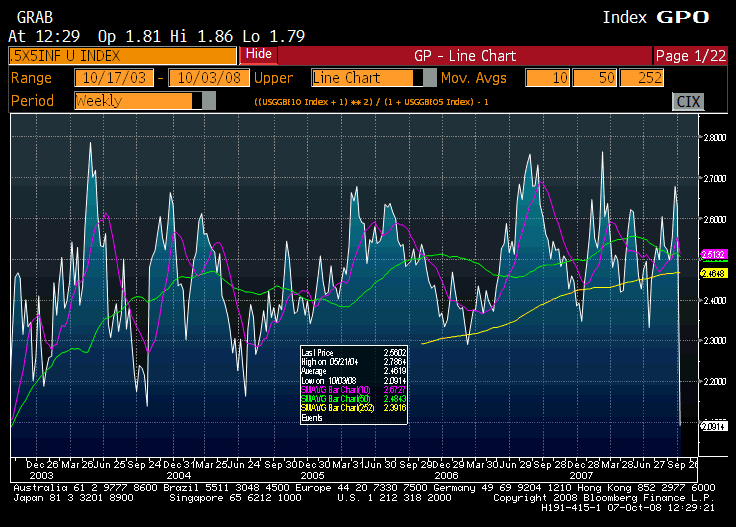I have been overloaded the past few days.? I took the FINRA series seven exam today and passed (88%, no section below 75%).? I may have my first client.? A dear friend of mine died.? The market has been lousy, and I have done worse than that.? Reporters have been regularly calling to talk about the markets.
When I thought I needed to reposition my portfolio a week ago, it was after the last H.4.1 report.? Well, the next one has come out and it is worse.? The Fed is stretching itself thin, with the aid of the Treasury.? I’ll post on that tomorrow.
I was a little surprised about some of the responses to my article on accounting rules not affecting cash flows.? Uh, that should be obvious.? But those that disagree point to arrangements where perceived reductions in credit quality lead to a need for more capital.
Let me first say that that is not a problem with the accounting rules.? It is a problem with liability stability.? What is the possibility of a run on the bank/company/fund?? Even if it is remote, have you guarded against it?
Runs occur in unusual ways.? Derivative agreements that require more collateral on a downgrade?? Enron-like structures that issue preferred to redeem senior debt, after some triggers are hit?? Uncertainty about ability to roll over short-term financing lines?? Ratings triggers on floating rate GICs?? Ratings triggers on regular GICs (a separate event)?? Ratings triggers on property-catastrophe reinsurance?? Over-reliance on factors to finance inventory?? Dare we mention the S&Ls in the late 80s/early 90s) Visiting the local loan shark each evening? 😉
Most insolvencies occur because assets are considerably less liquid than liabilities, and the margin of assets over liabilities on? a “fair value” basis is thin to negative.? The company is playing near the cliff, and is relying on the kindness of strangers not to push them over.
What I have been arguing for the last five years, whether here or at RealMoney, is that companies of all sorts need to play at a lower level of leverage.? FInancial slack is valuable, especially in a bear market.? Just ask Warren Buffett.
Almost any company that goes bankrupt, does so because the need to cash out liabilities runs ahead of their ability to cash out assets, without having fire sales where the total value of assets drops below that of liabilities.? I.e., they run out of cash!
That is why I don’t buy arguments that mark-to-market accounting is doing firms in.? First for financial firms, SFASs 133 and 157 don’t affect solvency, only the views of shareholders.? The regulatory/statutory accounting matters.? Also, private agreements, whether margin or derivative agreements, matter even more, because they can result in a call on cash during a crisis.? To eliminate MTM accounting is to eliminate doing business.? (Can you get a brokerage to look at your margin account only once a year, or less often?)
The problems for financial firms arise from too much debt that is too short term in order to finance longer dated assets.? They run the risk that they will hit a cash crunch.? Sorry, but that’s the way that it goes, and it doesn’t matter what the accounting rule is if you don’t leave sufficient margin to survive the worst case scenario.
The crises today boil down to an asset-liability mismatch in both time and liquidity, which are correlated.? It points toward a cash flow crunch, over which accounting rules have no control.? This is endemic to the market during crises.
Aside from all of the scholarly articles indicating that accounting rule changes have little impact on valuations, this line of argumentation explains why accounting changes have little effect on the prices of stocks.? If it doesn’t happen broadly, it is unlikely to happen narrowly.
Under the wrong circumstances, and we are living in wrong times now, almost any security can be equity-like, having an uncertain outcome.? Even T-bills face that uncertainty in purchasing power terms.? (Should we bring back the debates of adjusting accounting for inflation?? Dead issue for 20 years, could it live again?)? Equity-like instruments should be marked to the best current estimate of value, which does not mean last trade if the markets are thin.? Instead, if reliable markets don’t exist, and the calculation of market inputs is uncertain, then go back to a cash flow model with a “reasonable” discount rate.
If a thinly traded security is genuinely “money good” SFAS 157 offers enough flexibility to not mark it down heavily.? Granted, you might have an argument with your auditors and consultants, but SFAS 157 is not the ogre that everyone makes it out to be.? (The rating agencies, regulators and margin clerks may disagree though… and that means companies need a greater than normal provision against bad times.)
Nor is it freedom for a management to ignore the trading values of illiquid assets, because rating agencies and counterparties will still watch those factors, and a run on the company is as likely in a fog as on a sunny day.
The only way to avoid runs on the company is to hold enough slack assets that you know you will be alright in the worst of times, meaning a depression scenario, or, scenarios where nothing trades.? Does your company/strategy possess bicycle stability or table stability?? Is there a chair to sit on if the music stops?
What’s that you say?? Holding that much capital would kill our ROE?? That’s the thinking that got us into this mess, and is what makes risk management so tough, because the short run need for profits always leads to a diminution of risk control.? Now we are not only paying the price for it with individual companies, but across our corporate sector as a whole.
Deleveraging is painful.? There are almost always defaults and reductions of future profitability involved.? And, bailouts of the sort that our government that out government is pursuing have a low probability of success.? So, analyze your own investments for survivability this weekend.? Who can survive for two years without financing at any reasonable rate?? That’s an acid test.? I just wish that when I reviewed the recent actions of the Fed, I had acted more quickly.? Alas, perhaps my next post should be what do you do when you find yourself behind the curve…







October 7th, 2008 at 9:58 am I think you pegged it calling it the Super-SIV. As I commented in late 2007 as the Fed began this series of interventions in lending markets, it is easier to start these actions than to complete them. It is hard to estimate all of the consequences.Just as I think George Bush, Jr., started to go wrong when he concluded that he had found his mission (fight terrorism, without boundaries), Ben Bernanke faces a similar problem (do whatever it takes to stop the Second Great Depression, without boundaries).
History is being made here, and it will be volatile?
And jck responded:
October 7th, 2008 at 10:14 am one thing we know for sure, is that the policy of ?promoting? liquidity appears to have backfired, no reasonable person would claim that markets are functioning better now than when they started?in fact some people would say they are a lot worse.
as you say David, very hard to get out of this, I don?t expect to see a normal Fed balance sheet, i.e treasuries_t-bills in my lifetime.
I will pop in for a comment on your euro piece a bit later?busy???